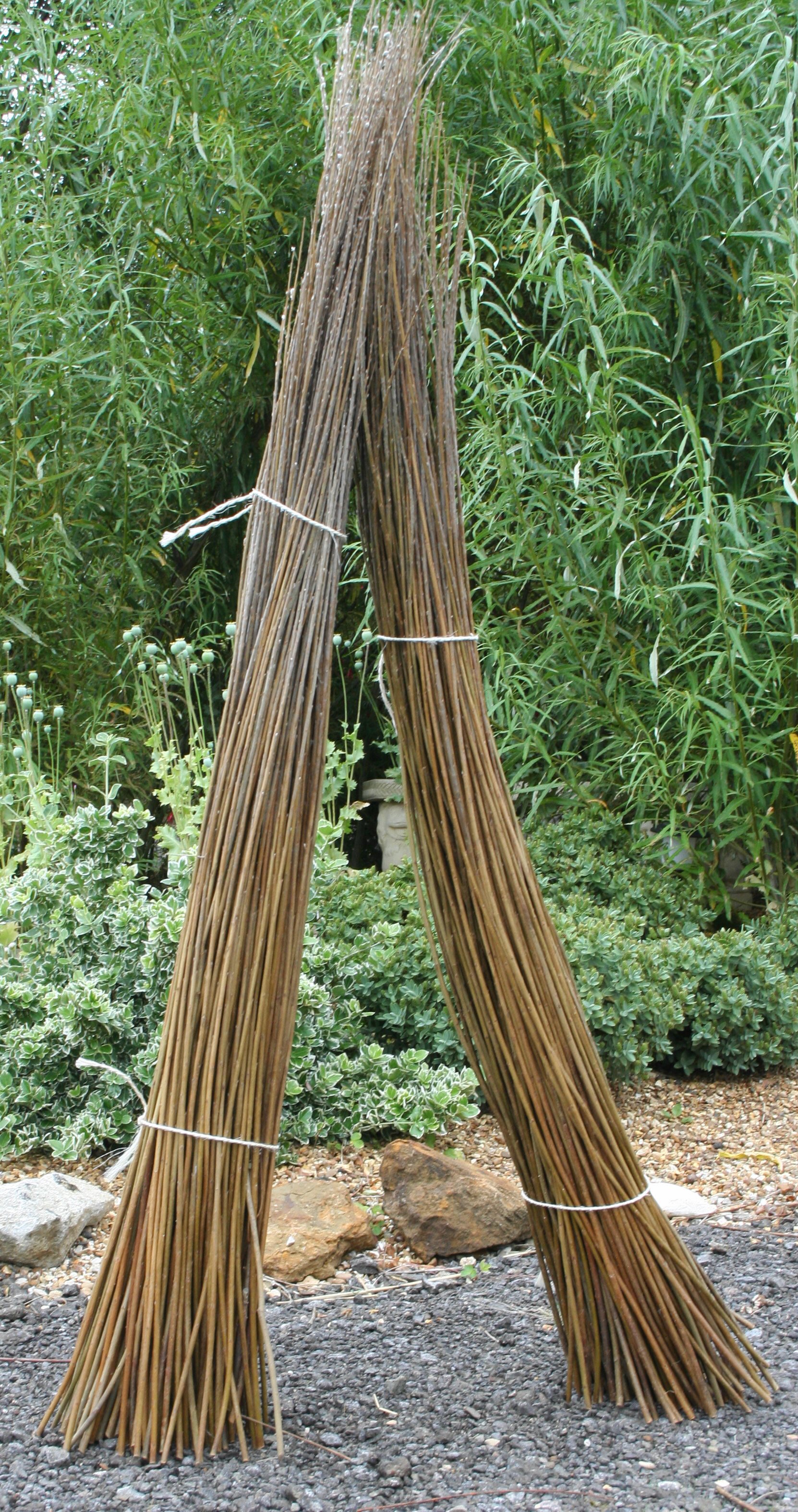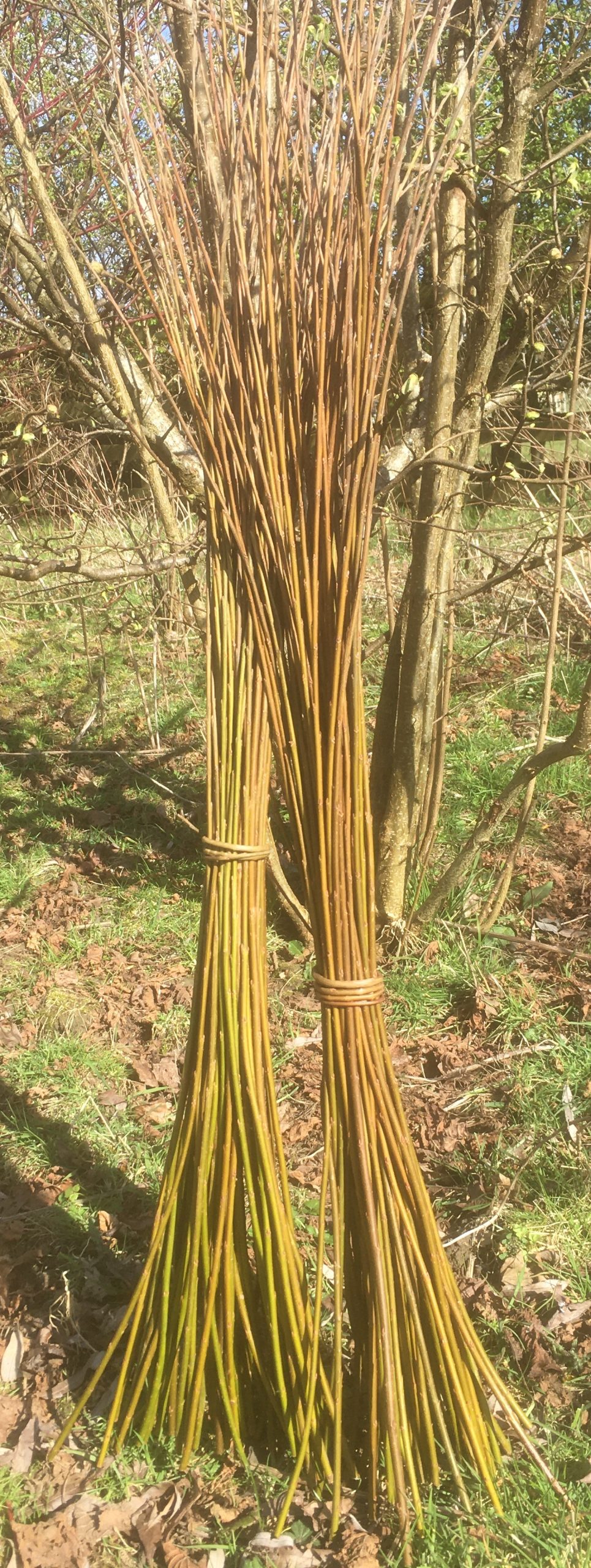'Dead' Willow from Willows Nursery
Storage, preparation and use of willow for weaving projects
‘Dead’ Willow Bundles WK106A , WK106B, WK106C, WK106D and WK106E
Our different bundles of mixed 3 to 5 ft, 4 to 6 ft and 2 1/2 to 3 1/2 ft lengths (0.9 to 1.5 m, 1.2 to 1.8 m and 75 cm to 105 cm) can be used for all sorts of simple weaving projects.
Using willow for ‘dead’ weaving projects :
When freshly harvested, willow is very pliable (it’s called green willow), and it remains so for several months if stored somewhere cool, dark and airy, such as a shady spot outside or in a garage or a shed.
If you make something with freshly cut willow be aware that the weaving will loosen as it dries and shrinks, potentially, leaving gaps in the weaving.
Ideally, you should wait, say, 6 weeks from cutting before using it to allow dry a little, whilst still being flexible.
If you’re using recently cut willow during the winter and early spring there should be no need to soak it

However, once the willow has become more dried (it’s then called brown willow) – from, say, late April onwards it will probably* need soaking before it is pliable enough to use.
*We say probably as it will depend on your planned use, willow that will break if you try to bend it too tightly may still be useable for other projects, such as garden edging, without soaking.
Soaking : Once your willow is too dry and brittle to work with for your project it will need to be soaked.
Where : Soak dried willow by totally submerging it in clean water (it will need weighing down as its inclination is to float !).
You can use a large tank or water butt (preferably keep it covered to reduce algae). Alternatives are a drain pipe sealed at one end or a soaking bag and customers in the past have planned to use a stream at the bottom of the garden (in which case make sure the willow is secured to stop it drifting away) and a pond – one was planning on using their swimming pool ! Some people are tempted to use their own bath – but be aware that the willow may cause staining.
For how long : How long to soak depends on the thickness of the stems and how dry they have become – it will, to a certain extent, be a case of trial and error. Soaking for too long and it may become slimy, too short a time and the willow will be too rigid still.
We have seen a rule of thumb that says soak for one day per foot of length so, four foot lengths of willow should be soaked for four days.
However, that doesn’t allow for how much the willow has dried out. In our experience, willow of around 6 ft long cut in the winter will need soaking for about 6 days in early summer, increasing to around 10 days in the autumn.
The temperature can also affect timings – soaking may need to be longer in colder weather and shorter in warmer weather.
One way to test if the willow has been soaked enough is to bend a whip at a right angle near the butt end (thick end) – dig a thumb nail in on the inside of the whip to help – if it cracks on the back of the bend it isn’t ready so put it back in to soak for another day or so.
Remember that shorter lengths of willow will be ready sooner than longer lengths – the longer lengths will have a thicker butt end that will need a bit longer soaking – so, maybe stagger putting very different sorted lengths in to soak.
Mellowing :
When the willow has been soaked for long enough, take it out of the water, rinse it down with clean water and stand it upright briefly, to allow excess water to run off – then wrap the willow in an old towel or blanket to mellow for a few hours or ideally overnight. This allows the willow to absorb moisture more fully and so be pliable for longer.
Following this process, the willow should be then be useable for a number of days if it is kept wrapped up and somewhere cool. Whilst you’re actually using the willow, keep it covered so that it doesn’t dry out.
Treatment of willow left outdoors :
After a few years, willow used outside – for hurdles, border edging, plant supports or garden decorations – will become more fragile from exposure to the elements. If it’s possible to take the woven willow into a drier environment for the worst of the winter weather, then this will help it last a little longer.
The generally recommended treatment for woven willow used outside to help prolong its life is a 50 : 50 mix of linseed oil and turps. Alternatively, try applying a general garden wood preservative.
Try to treat the willow at least once a year.
Extra hints & tips :
If you need to soak the willow before using it make sure you plan ahead – work out when you want to use the willow (and make sure you will have the time free to use it !) and calculate back to allow enough soaking time.
Most projects will need a mix of different lengths of willow – it helps to sort them into the lengths required before soaking/using them so that you can more easily lay your hand on what you need.
Only soak as much as you think you will need – any unused willow that is left over, can be dried out thoroughly and re-soaked when needed again – but don’t do this too many times. (If you forget about left over willow in the mellowing blanket you may find it has become mouldy !).
If you are in a hurry, soaking the willow in warmer water will shorten the soaking time.
Please have a look at our short ‘How to . . . ‘ videos to get people started on projects.